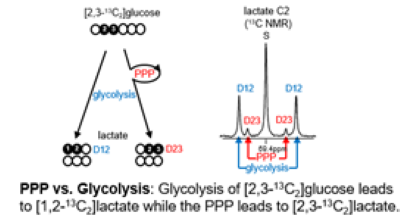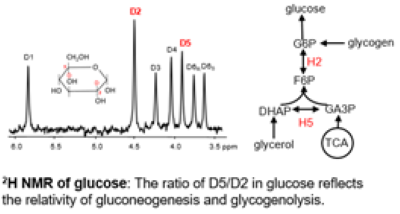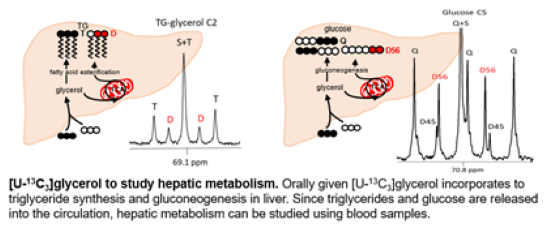NMR Spectroscopy and Isotopomer Analysis
The combination of stable isotopes and NMR spectroscopy for isotopomer analysis provides abundant information about metabolic pathways. Various simple substrates labeled with 2H or 13C have been applied in many different systems including isolated cells, perfused organs, human tissue biopsies obtained at surgery, mouse and human blood samples, etc. Published exams include those of normal physiology as well as diverse medical conditions such as metabolic syndrome, cardiac hypertrophy, and cancer. Here are a few examples of the studies involving the combination of a stable isotope and NMR spectroscopy currently undergoing at AIRC.
Assessment of the Pentose Phosphate Pathway
The pentose phosphate pathway (PPP) plays key roles in reductive biosynthesis, antioxidant activity, and nucleotide synthesis. Recently we introduced [2,3-13C2]glucose to simplify the assessment of PPP using 13C NMR. Glycolysis of [2,3-13C2]glucose leads to [1,2-13C2]lactate while the PPP leads to [2,3-13C2]lactate. These two products through glycolysis versus PPP can be easily quantified using 13C NMR of lactate C2. This novel approach has been applied to study the PPP activity in different organs and hepatomas. Currently, the PPP activity in kidney associated with diabetes is under investigation using [2,3-13C2]glucose.

Contact PI: Eunsook Jin, Craig Malloy
2H NMR to Study the Sources of Glucose
Glucose acts as the main energy source in the body. Two major sources of glucose in circulation include gluconeogenesis and glycogenolysis. The relativity of these processes can be measured using 2H NMR of glucose derivative after the administration of heavy water (2H2O). AIRC applied this approach, along with selective 13C-labeled substrates, to determine glucose production and supporting fluxes in volunteers with obesity, diabetes, or fatty liver. We study 2H-labeling patterns in glucose derived from blood, liver, and kidney using rodent models. This study aims to determine the relative contributions to blood glucose from the liver versus the kidney.

Contact PI: Eunsook Jin, Craig Malloy
Exploring Liver Metabolism In Vivo with [U-13C3]Glycerol
The liver mainly uses glycerol in the circulation, incorporating it into triglyceride synthesis or gluconeogenesis. In research with [U-13C3]glycerol, volunteers drink water containing the glycerol, then blood samples are drawn to study hepatic metabolism focusing on triglycerides and glucose released from the liver. 13C NMR of lipid extracts from blood informs fatty acid esterification through direct [U-13C3]glycerol incorporation or indirect incorporation via the TCA cycle. Similarly, 13C NMR of glucose reveals more about [U-13C3]glycerol incorporation to glucose through different pathways. We applied this method to studies about polycystic ovary syndrome, nonalcoholic fatty liver disease, and the impact of empagliflozin on obese adults.

Contact PI: Eunsook Jin, Craig Malloy
